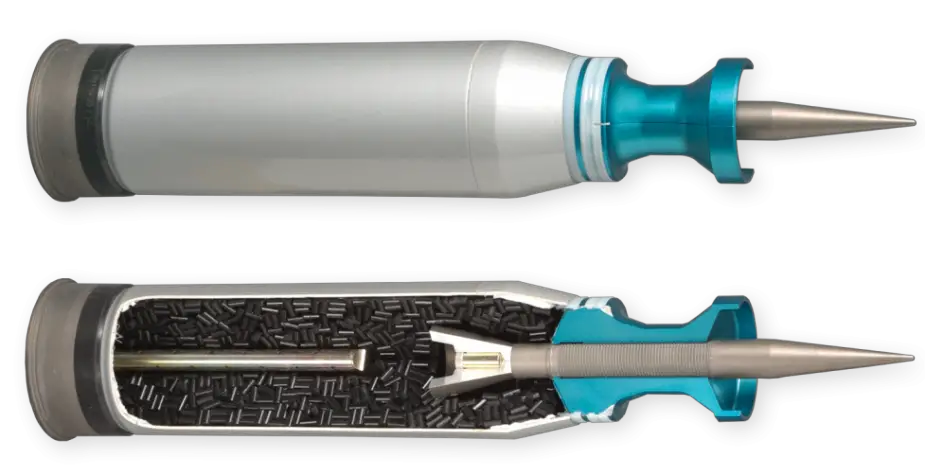General Dynamics Ordnance and Tactical Systems was awarded a $19,100,140 modification (P00029) to contract W52P1J-17-C0024 to procure 120mm M865A1 new production cartridges for 120mm tank training ammunition.

Armor crewmen assigned to Task Force Raider load Sabot rounds onto an Abrams MBT during a pre-deployment training exercise at Fort Hood. Sabot rounds work like a basic arrow by penetrating armor with momentum of force rather than explosive power. (Picture source: U.S. Army/Sgt. Sarah Kirby)
Bids were solicited via the internet with two received. Work will be performed in St. Petersburg, Florida, with an estimated completion date of March 31, 2022. Fiscal 2019 and 2020 procurement of ammunition, Army funds in the amount of $19,100,140 were obligated at the time of the award. U.S. Army Contracting Command, Rock Island Arsenal, Illinois, is the contracting activity.
The M865 TPCSDS-T Kinetic Energy (KE) training round, in service with the United States Army’s main battle tank fleet, utilizes a unique cone stabilizer to limit the safety fan required for tank gunnery. With its matched exterior ballistics, the M865 provides a realistic training device displaying the accuracy and time-of-flight of the service round. The cone stabilizer provides a safety feature limiting the overall flight range to under 8 km, reducing the requirement for extreme range safety fans. Utilizing the same combustible cartridge case as the service round, and designed to resemble the 120mm M829 Armor-Piercing, Fin-Stabilized, Discarding-Sabot Tracer (APFSDS-T) rounds in operational performance. The M865 represents a valuable KE training surrogate for the 120mm smoothbore weapon system.

M865 TPCSDS-T Kinetic Energy (KE) training round (Picture source: General Dynamics)
M1A2 Abrams 120mm gun
The main armament of the M1A1 and M1A2 is the M256A1 120 mm smoothbore gun, designed by Rheinmetall AG of Germany, manufactured under license in the U.S. by Watervliet Arsenal, New York. The M256A1 is a variant of the Rheinmetall 120 mm L/44 gun carried on the German Leopard 2 on all variants up to the Leopard 2A5. Leopard 2A6 replaced the L/44 barrel with a longer L/55. Due to the increased caliber, only 40 or 42 rounds are able to be stored depending on if the tank is an A1 or A2 model.
The M256A1 fires a variety of rounds. The primary APFSDS round of the Abrams is the depleted uranium M829 round, of which four variants have been designed. M829A1, known as the "Silver Bullet", saw widespread service in the Gulf War, where it proved itself against Iraqi armor such as the T-72. The M829A2 APFSDS round was developed specifically as an immediate solution to address the improved protection of a Russian T-72, T-80U or T-90 main battle tank equipped with Kontakt-5 explosive reactive armor (ERA) as previous rounds were found to be incapable of defeating such armor. Later, the M829A3 round was introduced to improve its effectiveness against next-generation ERA equipped tanks, through the usage of a multi-material penetrator and increased penetrator diameter that can resist the shear effect of K-5 type ERA.[citation needed] As a counter to that, the Russian army introduced Relikt, the most modern Russian ERA, which is claimed to be twice as effective as Kontakt-5. Development of the M829 series is continuing with the M829A4 currently entering production, featuring advanced technology such as data-link capability. The Abrams also fires high-explosive anti-tank warhead shaped charge rounds such as the M830, the latest version of which (M830A1) incorporates a sophisticated multi-mode electronic sensing fuse and more fragmentation that allows it to be used effectively against armored vehicles, personnel, and low-flying aircraft. The Abrams uses a manual loader. The fourth tank crew member on the Abrams also provides additional support for maintenance, observation post/listening post (OP/LP) operations, and other tasks.
The new M1028 120 mm anti-personnel canister cartridge was brought into service early for use in the aftermath of the 2003 invasion of Iraq. It contains 1,098 3⁄8-inch (9.5 mm) tungsten balls that spread from the muzzle to produce a shotgun effect lethal out to 600 meters (2,000 ft). The tungsten balls can be used to clear enemy dismounts, break up hasty ambush sites in urban areas, clear defiles, stop infantry attacks and counter-attacks and support friendly infantry assaults by providing covering fire. The canister round is also a highly effective breaching round and can level cinder block walls and knock man-sized holes in reinforced concrete walls for infantry raids at distances up to 75 meters (246 ft). Also in use is the M908 obstacle-reduction round. It is designed to destroy obstacles and barriers. The round is a modified M830A1 with the front fuse replaced by a steel nose to penetrate into the obstacle before detonation.














